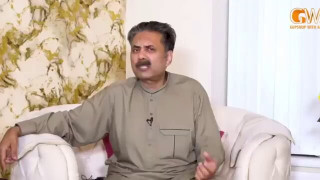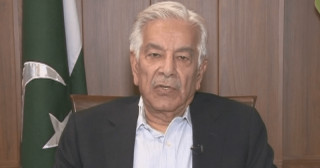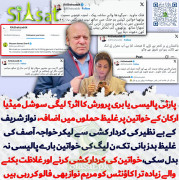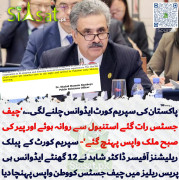karachiwala
Prime Minister (20k+ posts)
Of all the Muslim rulers who ruled vast territories of India from 712 to 1857 CE, probably no one has received as much condemnation from Western and Hindu writers as Aurangzeb. He has been castigated as a religious Muslim who was anti-Hindu, who taxed them, who tried to convert them, who discriminated against them in awarding high administrative positions, and who interfered in their religious matters. This view has been heavily promoted in the government approved textbooks in schools and colleges across post-partition India (i.e., after 1947). These are fabrications against one of the best rulers of India who was pious, scholarly, saintly, un-biased, liberal, magnanimous, tolerant, competent, and far-sighted.
Fortunately, in recent years quite a few Hindu historians have come out in the open disputing those allegations. For example, historian Babu Nagendranath Banerjee rejected the accusation of forced conversion of Hindus by Muslim rulers by stating that if that was their intention then in India today there would not be nearly four times as many Hindus compared to Muslims, despite the fact that Muslims had ruled for nearly a thousand years. Banerjee challenged the Hindu hypothesis that Aurangzeb was anti-Hindu by reasoning that if the latter were truly guilty of such bigotry, how could he appoint a Hindu as his military commander-in-chief? Surely, he could have afforded to appoint a competent Muslim general in that position. Banerjee further stated: "No one should accuse Aurangzeb of being communal minded. In his administration, the state policy was formulated by Hindus. Two Hindus held the highest position in the State Treasury. Some prejudiced Muslims even questioned the merit of his decision to appoint non-Muslims to such high offices. The Emperor refuted that by stating that he had been following the dictates of the Shariah (Islamic Law) which demands appointing right persons in right positions." During Aurangzeb's long reign of fifty years, many Hindus, notably Jaswant Singh, Raja Rajrup, Kabir Singh, Arghanath Singh, Prem Dev Singh, Dilip Roy, and Rasik Lal Crory, held very high administrative positions. Two of the highest ranked generals in Aurangzeb's administration, Jaswant Singh and Jaya Singh, were Hindus. Other notable Hindu generals who commanded a garrison of two to five thousand soldiers were Raja Vim Singh of Udaypur, Indra Singh, Achalaji and Arjuji. One wonders if Aurangzeb was hostile to Hindus, why would he position all these Hindus to high positions of authority, especially in the military, who could have mutinied against him and removed him from his throne?
Most Hindus like Akbar over Aurangzeb for his multi-ethnic court where Hindus were favored. Historian Shri Sharma states that while Emperor Akbar had fourteen Hindu Mansabdars (high officials) in his court, Aurangzeb actually had 148 Hindu high officials in his court. (Ref: Mughal Government) But this fact is somewhat less known.
Some of the Hindu historians have accused Aurangzeb of demolishing Hindu Temples. How factual is this accusation against a man, who has been known to be a saintly man, a strict adherent of Islam? The Qur'an prohibits any Muslim to impose his will on a non-Muslim by stating that "There is no compulsion in religion." (surah al-Baqarah 2:256). The surah al-Kafirun clearly states: "To you is your religion and to me is mine." It would be totally unbecoming of a learned scholar of Islam of his caliber, as Aurangzeb was known to be, to do things that are contrary to the dictates of the Qur'an.
Interestingly, the 1946 edition of the history textbook Etihash Parichaya (Introduction to History) used in Bengal for the 5th and 6th graders states: "If Aurangzeb had the intention of demolishing temples to make way for mosques, there would not have been a single temple standing erect in India. On the contrary, Aurangzeb donated huge estates for use as Temple sites and support thereof in Benares, Kashmir and elsewhere. The official documentations for these land grants are still extant."
A stone inscription in the historic Balaji or Vishnu Temple, located north of Chitrakut Balaghat, still shows that it was commissioned by the Emperor himself. The proof of Aurangzeb's land grant for famous Hindu religious sites in Kasi, Varanasi can easily be verified from the deed records extant at those sites. The same textbook reads: "During the fifty year reign of Aurangzeb, not a single Hindu was forced to embrace Islam. He did not interfere with any Hindu religious activities." (p. 138) Alexander Hamilton, a British historian, toured India towards the end of Aurangzeb's fifty year reign and observed that every one was free to serve and worship God in his own way.
Now let us deal with Aurangzeb's imposition ofthe jizya tax which had drawn severe criticism from many Hindu historians. It is true that jizya was lifted during the reign of Akbar and Jahangir and that Aurangzeb later reinstated this. Before I delve into the subject of Aurangzeb's jizya tax, or taxing the non-Muslims, it is worthwhile to point out that jizya is nothing more than a war tax which was collected only from able-bodied young non-Muslim male citizens living in a Muslim country who did not want to volunteer for the defense of the country. That is, no such tax was collected from non-Muslims who volunteered to defend the country. This tax was not collected from women, and neither from immature males nor from disabled or old male citizens. For payment of such taxes, it became incumbent upon the Muslim government to protect the life, property and wealth of its non-Muslim citizens. If for any reason the government failed to protect its citizens, especially during a war, the taxable amount was returned.
It should be pointed out here that zakat (2.5% of savings) and ushr (10% of agricultural products) were collected from all Muslims, who owned some wealth (beyond a certain minimum, called nisab). They also paid sadaqah, fitrah, and khums. None of these were collected from any non-Muslim. As a matter of fact, the per capita collection from Muslims was several fold that of non-Muslims. Further to Auranzeb's credit is his abolition of a lot of taxes, although this fact is not usually mentioned. In his book Mughal Administration, Sir Jadunath Sarkar, foremost historian on the Mughal dynasty, mentions that during Aurangzeb's reign in power, nearly sixty-five types of taxes were abolished, which resulted in a yearly revenue loss of fifty million rupees from the state treasury.
While some Hindu historians are retracting the lies, the textbooks and historic accounts in Western countries have yet to admit their error and set the record straight.
Fortunately, in recent years quite a few Hindu historians have come out in the open disputing those allegations. For example, historian Babu Nagendranath Banerjee rejected the accusation of forced conversion of Hindus by Muslim rulers by stating that if that was their intention then in India today there would not be nearly four times as many Hindus compared to Muslims, despite the fact that Muslims had ruled for nearly a thousand years. Banerjee challenged the Hindu hypothesis that Aurangzeb was anti-Hindu by reasoning that if the latter were truly guilty of such bigotry, how could he appoint a Hindu as his military commander-in-chief? Surely, he could have afforded to appoint a competent Muslim general in that position. Banerjee further stated: "No one should accuse Aurangzeb of being communal minded. In his administration, the state policy was formulated by Hindus. Two Hindus held the highest position in the State Treasury. Some prejudiced Muslims even questioned the merit of his decision to appoint non-Muslims to such high offices. The Emperor refuted that by stating that he had been following the dictates of the Shariah (Islamic Law) which demands appointing right persons in right positions." During Aurangzeb's long reign of fifty years, many Hindus, notably Jaswant Singh, Raja Rajrup, Kabir Singh, Arghanath Singh, Prem Dev Singh, Dilip Roy, and Rasik Lal Crory, held very high administrative positions. Two of the highest ranked generals in Aurangzeb's administration, Jaswant Singh and Jaya Singh, were Hindus. Other notable Hindu generals who commanded a garrison of two to five thousand soldiers were Raja Vim Singh of Udaypur, Indra Singh, Achalaji and Arjuji. One wonders if Aurangzeb was hostile to Hindus, why would he position all these Hindus to high positions of authority, especially in the military, who could have mutinied against him and removed him from his throne?
Most Hindus like Akbar over Aurangzeb for his multi-ethnic court where Hindus were favored. Historian Shri Sharma states that while Emperor Akbar had fourteen Hindu Mansabdars (high officials) in his court, Aurangzeb actually had 148 Hindu high officials in his court. (Ref: Mughal Government) But this fact is somewhat less known.
Some of the Hindu historians have accused Aurangzeb of demolishing Hindu Temples. How factual is this accusation against a man, who has been known to be a saintly man, a strict adherent of Islam? The Qur'an prohibits any Muslim to impose his will on a non-Muslim by stating that "There is no compulsion in religion." (surah al-Baqarah 2:256). The surah al-Kafirun clearly states: "To you is your religion and to me is mine." It would be totally unbecoming of a learned scholar of Islam of his caliber, as Aurangzeb was known to be, to do things that are contrary to the dictates of the Qur'an.
Interestingly, the 1946 edition of the history textbook Etihash Parichaya (Introduction to History) used in Bengal for the 5th and 6th graders states: "If Aurangzeb had the intention of demolishing temples to make way for mosques, there would not have been a single temple standing erect in India. On the contrary, Aurangzeb donated huge estates for use as Temple sites and support thereof in Benares, Kashmir and elsewhere. The official documentations for these land grants are still extant."
A stone inscription in the historic Balaji or Vishnu Temple, located north of Chitrakut Balaghat, still shows that it was commissioned by the Emperor himself. The proof of Aurangzeb's land grant for famous Hindu religious sites in Kasi, Varanasi can easily be verified from the deed records extant at those sites. The same textbook reads: "During the fifty year reign of Aurangzeb, not a single Hindu was forced to embrace Islam. He did not interfere with any Hindu religious activities." (p. 138) Alexander Hamilton, a British historian, toured India towards the end of Aurangzeb's fifty year reign and observed that every one was free to serve and worship God in his own way.
Now let us deal with Aurangzeb's imposition ofthe jizya tax which had drawn severe criticism from many Hindu historians. It is true that jizya was lifted during the reign of Akbar and Jahangir and that Aurangzeb later reinstated this. Before I delve into the subject of Aurangzeb's jizya tax, or taxing the non-Muslims, it is worthwhile to point out that jizya is nothing more than a war tax which was collected only from able-bodied young non-Muslim male citizens living in a Muslim country who did not want to volunteer for the defense of the country. That is, no such tax was collected from non-Muslims who volunteered to defend the country. This tax was not collected from women, and neither from immature males nor from disabled or old male citizens. For payment of such taxes, it became incumbent upon the Muslim government to protect the life, property and wealth of its non-Muslim citizens. If for any reason the government failed to protect its citizens, especially during a war, the taxable amount was returned.
It should be pointed out here that zakat (2.5% of savings) and ushr (10% of agricultural products) were collected from all Muslims, who owned some wealth (beyond a certain minimum, called nisab). They also paid sadaqah, fitrah, and khums. None of these were collected from any non-Muslim. As a matter of fact, the per capita collection from Muslims was several fold that of non-Muslims. Further to Auranzeb's credit is his abolition of a lot of taxes, although this fact is not usually mentioned. In his book Mughal Administration, Sir Jadunath Sarkar, foremost historian on the Mughal dynasty, mentions that during Aurangzeb's reign in power, nearly sixty-five types of taxes were abolished, which resulted in a yearly revenue loss of fifty million rupees from the state treasury.
While some Hindu historians are retracting the lies, the textbooks and historic accounts in Western countries have yet to admit their error and set the record straight.




































